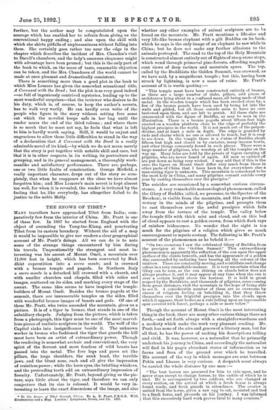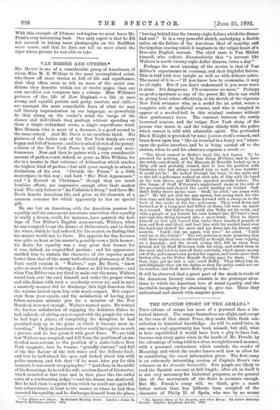THE SNOWS OF TIBET.*
MANY travellers have approached Tibet from India; com- paratively few from the interior of China. Mr. Pratt is one of these few. In 1887 he started from England with the object of ascending the Yang-tze-Kiang, and penetrating Tibet from its eastern boundary. Without the aid of a map it would be impossible to give our readers a clear geographical account of Mr. Pratt's doings. All we can do is to note some of the strange things encountered by him daring his travels. Unquestionably the strangest and most in- teresting was his ascent of Mount Omei, a mountain over 11,000 feet in height, which has been converted by Bud- dhist superstition into a sacro monte, and is crowned with a bronze temple and pagoda. In Northern Italy a sacro monte is a detached hill crowned with a church, and with smaller churches and chapels. filled with relics and images, scattered on its sides, and marking every stage of the ascent. The same idea seems to have inspired the temple- builders of Mount Omei. Besides the bronze pagoda at the summit, there are innumerable temples on the sides, filled with wonderful bronze images of beasts and gods. Of one of these Mr. Pratt, who twice ascended the mountain, gives us a picture. It is of a tiger in bronze, that stands in one of the subsidiary chapels. Judging from the picture, which is taken from a photograph, this tiger must be one of the most marvel- lous pieces of realistic sculpture in the world. The wolf of the Capitol sinks into insignificance beside it. The unknown worker in bronze who fashioned the tiger that guards the hill Must have been an artist of extraordinary power. Though the rendering is somewhat archaic and conventional, the very spirit of the fiercest and most fearless of wild beasts has passed into the metal. The fore legs and paws set like pillars, the huge shoulders, the sunk head, the terrible jaws, and the blunt nose, each and all give the impression of resistless power; while the keen eyes, the bristling whiskers, and the protruding teeth add an extraordinary impression of ferocity. Unfortunately, Mr. Pratt, beyond giving us the pic- ture, says little about the tiger, and therefore we can only conjecture that its size is colossal. It would be very in- teresting to learn the exact dimensions of the image, and also • To the Snow, of TIM through China. By A. E. Pratt, F.R.0.8. With Illustrations and a flap. London : Longman, Green, and Co. 1892.
whether any other examples of animal sculpture are to he found on the mountain. Mr. Pratt mentions a life-size and very life-like bronze elephant with a gilt Buddha on its back, which he says is the only image of an elephant he saw while in China; but he does not make any further allusions to the animals portrayed. The road to the top of the Holy Mountain is constructed almost entirely out of flights of steep stone steps, which wend through primaeval pine-forests, affording magnifi- cent views of deep ravines and mountain spurs. The top, called by the Buddhists the Golden Summit, was crowned, as we have said, by a magnificent temple ; but this, having been struck by lightning, is now a mass of ruins. Mr. Pratt's account of it is worth quoting :—
" This temple must have been constructed entirely of bronze, as there are a large number of slabs, pillars, and pieces of architraves lying about in a confused mass, all being made of that metal. In the wooden temple which has been erected close by, a few of the bronze panels have been used by being let into the walls and gilded, but all those outside seem to have no care bestowed upon them, and are left to perish. All these slabs are ornamented with the figure of Buddha, as may be seen in the illustration. There is a bronze pagoda about fifteen feet high erected on a wooden platform close to the edge of probably the highest precipice in the world. It is not much out of the perpen- dicular, and at least a mile in depth. The edge is guarded by rails and chains which no one is allowed to touch, but it is easy to see down. In the temple there is a statue of Buddha about fifteen feet high and closed in by curtains, many incense bowls, and other things commonly found in such places. There were a large number of pilgrims, who worship at all the temples on the way up. Many tales are told by the priests of tigers carrying off pilgrims, who are never heard of again. All men so carried off are put down as being very wicked. I may add that if this is the case, the tigers on Mount Omei differ very much from those in other parts of China that I have been in, for everywhere else a man-eating tiger is unknown. This mountain is considered to be the most holy in China, and many pilgrims commit suicide every year by casting themselves over the precipice."
The suicides are occasioned by a somewhat curious circum- stance. A very remarkable meteorological phenomenon, called the Glory of Buddha (allied, we presume, to the Spectre of the Brocken), is visible from the mountain, and this produces an ecstasy in the minds of the pilgrims, and prompts them to cast themselves over the awful precipice which falls away from the terrace of the temple. The valley below the temple fills with thick mist and cloud, and on this bed of cloud appears to rest a golden crown, from which flash rays
of rainbow iridescence. No wonder that the sight is tco much for the pilgrims of a religion which gives so much encouragement to mystic ecstasy. The following is Mr. Pratt's account of the phenomenon as he beheld it :— " On two occasions I saw the celebrated Glory of Buddha from the precipice at the Golden Summit.' This extraordinary phenomenon is apparently the reflection of the sun upon the upper surface of the clouds beneath, and has the appearance of a golden disc surrounded by radiating bars bearing all the colours of the rainbow. These are constantly moving, and scintillate and change colour in a very remarkable manner. It is very uncertain when the Glory can be seen, as the sun shining on clouds below does not always produce it, and it may appear at any time when the sun is over a certain height above the horizon. It is held in great respect by the Buddhists, and thousands of pilgrims, some coming from great distances, visit the mountain in the hope of being able to see it. A considerable number of them are so overcome by excess of religious feeling on beholding it, that they throw themselves over the frightful precipice into the clouds upon which it appears, their bodies as a rule falling upon an inaccessible spur covered with forest, perhaps a mile or more below."
Though the account of Mount Omei is the most interesting thing in the book, there are many other curious things there set forth,—and set forth always with a straightforwardness and a modesty which make the work very pleasant reading. Mr. Pratt has none of the airs and graces of a literary man, but for all that, he has the power of making his descriptions telling and vivid. It was, however, as a naturalist that he primarily undertook his journey in China, and accordingly the naturalist will find in his pages abundant stores of information as to fauna and flora of the ground over which he travelled. His account of the way in which messages are sent between Pekin and Lhassa is very curious. A despatch must always be carried the whole distance by one man :—
" The best horses are procured for him to ride upon, and he never stops except to change horses, to the saddle of which he is tied. He is accompanied by two soldiers, who are changed at every station, on the arrival at which a fresh horse is always found ready, and fresh guards in attendance. The courier is untied from the horse, given a raw egg to eat, mounted and tied to a fresh horse, and proceeds on his journey. I was informed
that this excessively hard work proves fatal to many couriers."
With this example of Chinese red-tapism we must leave Mr.
• Pratt's very interesting book. Our only regret is that he did not succeed in taking more photographs on the Buddhist sacro monte, and that he does not tell us more about the tiger whose picture he was able to take.



































 Previous page
Previous page